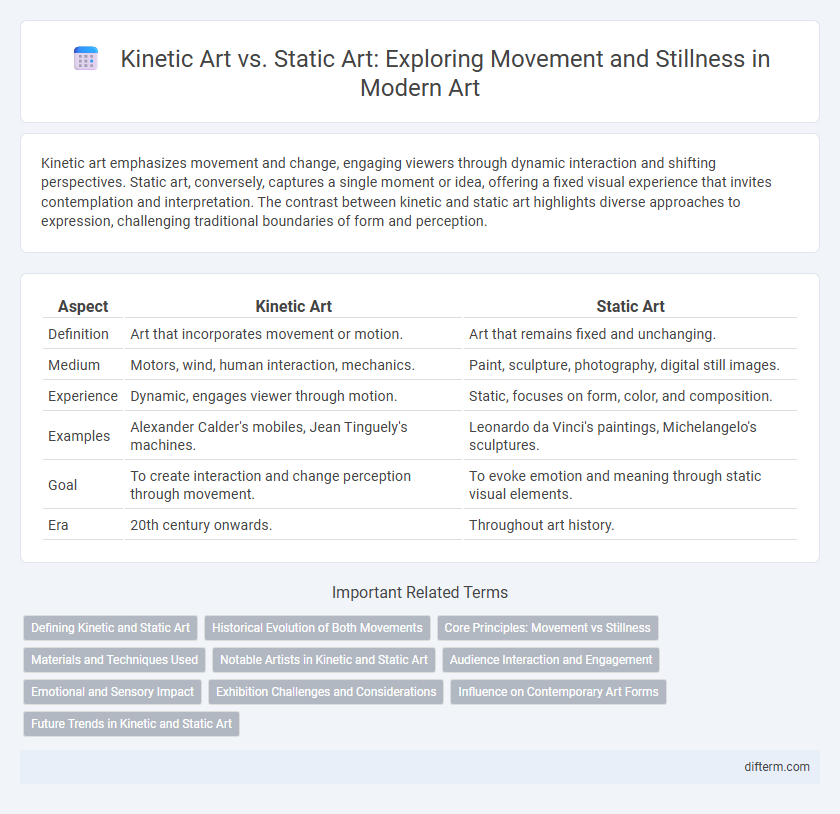Kinetic art emphasizes movement and change, engaging viewers through dynamic interaction and shifting perspectives. Static art, conversely, captures a single moment or idea, offering a fixed visual experience that invites contemplation and interpretation. The contrast between kinetic and static art highlights diverse approaches to expression, challenging traditional boundaries of form and perception.
Table of Comparison
| Aspect | Kinetic Art | Static Art |
|---|---|---|
| Definition | Art that incorporates movement or motion. | Art that remains fixed and unchanging. |
| Medium | Motors, wind, human interaction, mechanics. | Paint, sculpture, photography, digital still images. |
| Experience | Dynamic, engages viewer through motion. | Static, focuses on form, color, and composition. |
| Examples | Alexander Calder's mobiles, Jean Tinguely's machines. | Leonardo da Vinci's paintings, Michelangelo's sculptures. |
| Goal | To create interaction and change perception through movement. | To evoke emotion and meaning through static visual elements. |
| Era | 20th century onwards. | Throughout art history. |
Defining Kinetic and Static Art
Kinetic art is defined by its incorporation of movement, either through mechanical means or natural forces, creating dynamic visual experiences that change over time. Static art, in contrast, remains motionless, relying on form, color, and composition to evoke emotion and meaning without physical change. Understanding these distinctions highlights the unique sensory engagement offered by kinetic art compared to the contemplative stillness of static works.
Historical Evolution of Both Movements
Kinetic art emerged in the early 20th century, influenced by Futurism and Constructivism, emphasizing movement and mechanization as seen in works by artists like Alexander Calder and Jean Tinguely. Static art, rooted in classical traditions, maintained a focus on fixed forms and stillness, evolving through periods such as Renaissance and Modernism with artists like Michelangelo and Piet Mondrian. The historical evolution of kinetic versus static art reflects a shift from representing eternal forms to exploring dynamic motion and interactivity within the artistic experience.
Core Principles: Movement vs Stillness
Kinetic art emphasizes movement, capturing dynamic energy through motion, light, and interaction, which engages viewers in an evolving experience. Static art relies on fixed forms and stillness, focusing on composition, texture, and color to evoke emotions and ideas in a single, unchanging moment. Both art forms harness visual elements to communicate meaning but diverge fundamentally in their use of temporal change versus permanence.
Materials and Techniques Used
Kinetic art utilizes materials such as motors, sensors, and lightweight metals to create movement and interactivity, often employing techniques like engineering mechanics and electronic control systems. Static art relies on traditional materials like canvas, stone, and wood, with techniques including painting, sculpting, and carving to establish a fixed visual presence. The contrast in materials and techniques highlights kinetic art's dynamic physicality versus static art's enduring, unmoving form.
Notable Artists in Kinetic and Static Art
Notable artists in kinetic art include Alexander Calder, renowned for his pioneering mobiles, and Jean Tinguely, famous for his mechanical sculptures that engage movement and viewer interaction. In static art, key figures such as Pablo Picasso and Frida Kahlo are celebrated for their influential paintings that convey emotion and narrative without motion. The distinction between kinetic and static art lies in the incorporation of movement, with Calder's mobiles and Tinguely's machines exemplifying dynamic, evolving forms as opposed to the fixed compositions found in Picasso's cubism and Kahlo's vivid self-portraits.
Audience Interaction and Engagement
Kinetic art captivates audiences through dynamic movement and interactive elements, fostering a more immersive and participatory experience compared to static art. The shifting forms and motion in kinetic pieces actively engage viewers, inviting them to explore different perspectives and sensory responses. Static art, while visually impactful, often relies on contemplation and interpretation without physical interaction, resulting in a more passive engagement from the audience.
Emotional and Sensory Impact
Kinetic art engages viewers through movement, creating a dynamic sensory experience that elicits emotions such as excitement and curiosity by stimulating visual and sometimes tactile senses. Static art relies on color, texture, and composition to evoke emotions like calmness or contemplation, encouraging deeper introspection. The emotional impact of kinetic art is often immediate and visceral, while static art invites prolonged reflection and personal interpretation.
Exhibition Challenges and Considerations
Exhibiting kinetic art requires specialized infrastructure to support moving parts, precise electrical systems, and safety measures, contrasting with static art's simpler display needs. Curators must consider continuous mechanical maintenance and potential malfunctions that can disrupt viewer experience during exhibitions. Static art benefits from stability and ease of installation, but kinetic art's dynamic nature often demands higher costs and technical expertise for successful presentation.
Influence on Contemporary Art Forms
Kinetic art revolutionized contemporary art by introducing movement and viewer interaction as central elements, contrasting with the fixed forms of static art. This dynamic quality influenced digital installations, performance art, and interactive media, expanding the definition of art beyond traditional boundaries. Contemporary artists draw on kinetic principles to explore temporality, audience engagement, and the integration of technology in artistic expression.
Future Trends in Kinetic and Static Art
Future trends in kinetic art emphasize interactive technologies, incorporating robotics and augmented reality to create dynamic, evolving installations that engage multiple senses. Static art, while traditionally unchanging, is increasingly embracing digital augmentation and mixed media to enhance viewer experience and reinterpret classic forms. Both art forms are converging through hybrid practices that challenge traditional boundaries, driven by advancements in AI and immersive exhibition techniques.
kinetic art vs static art Infographic

 difterm.com
difterm.com